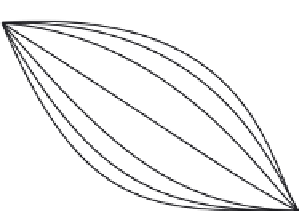Graphics Reference
In-Depth Information
k
0
1.0
k
0
0.8
0.6
0.4
0.2
k
0
0.2
0.4
0.6
0.8
1.0
i
/(
n
1)
FIGURE 4.9
Power functions of
Equation 4.1
for various values of
k
.
These attenuation functions are easy to compute and provide sufficient flexibility for many desired
effects. When
k¼
zero it corresponds to a linear attenuation, while values of
k<
0 create a more elastic
impression. Values of
k>
0 create the effect of more rigid displacements (
Figure 4.9
)
.
4.3.2
Deforming an embedding space
A popular technique for modifying the shape of an object is credited to Sederberg [
31
]
and is called
free-form deformation
(FFD). FFD is only one of a number of techniques that share a similar approach,
establishing a local coordinate system that encases the area of the object to be distorted. The initial
configuration of the local coordinate system is such that the determination of the local coordinates
of a vertex is a simple process. Typically, the initial configuration has orthogonal axes. The object
to be distorted, whose vertices are defined in global coordinates, is then placed in this local coordinate
space by determining the local coordinates of its vertices. The local coordinate system is distorted by
the user in some way, and the local coordinates of the vertices are used to map their positions in global
space. The idea behind these techniques is that it is easier or more intuitive for the user to manipulate
the local coordinate system than to manipulate the vertices of the object. Of course, the trade-off is that
the manipulation of the object is restricted to possible distortions of the coordinate system. The local
coordinate grid is usually distorted so that the mapping is continuous (space is not torn apart), but it can
be nonlinear, making this technique more powerful than affine transformations.
Two-dimensional grid deformation
Before discussing three-dimensional deformation techniques, simpler two-dimensional schemes are
work, Peter Foldes, Nestor Burtnyk, and Marceli Wein used a two-dimensional technique that
allowed for shape deformation. In this technique, the local coordinate system is a two-dimensional
grid in which an object is placed. The grid is initially aligned with the global axes so that the mapping
from local to global coordinates consists of a scale and a translation. For example, in
Figure 4.10
,
assume that the local grid vertices are defined at global integer values from 20 to 28 in
x
and from




















Search WWH ::

Custom Search